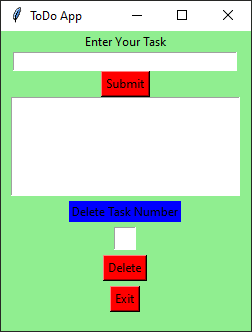Python|使用 Tkinter 的 ToDo GUI 应用程序
先决条件: tkinter 简介
Python为开发 GUI(图形用户界面)提供了多种选择。在所有的 GUI 方法中,Tkinter 是最常用的方法。在本文中,我们将通过分步指南学习如何使用 Tkinter 创建 ToDo GUI 应用程序。
创建一个 tkinter :
- 导入模块 – tkinter
- 创建主窗口(容器)
- 将任意数量的小部件添加到主窗口。
- 在小部件上应用事件触发器。
GUI 如下所示:

让我们创建一个基于 GUI 的简单 ToDo 应用程序,您可以在其中添加和删除任务。
下面是实现:
Python3
# import all functions from the tkinter
from tkinter import *
# import messagebox class from tkinter
from tkinter import messagebox
# global list is declare for storing all the task
tasks_list = []
# global variable is declare for counting the task
counter = 1
# Function for checking input error when
# empty input is given in task field
def inputError() :
# check for enter task field is empty or not
if enterTaskField.get() == "" :
# show the error message
messagebox.showerror("Input Error")
return 0
return 1
# Function for clearing the contents
# of task number text field
def clear_taskNumberField() :
# clear the content of task number text field
taskNumberField.delete(0.0, END)
# Function for clearing the contents
# of task entry field
def clear_taskField() :
# clear the content of task field entry box
enterTaskField.delete(0, END)
# Function for inserting the contents
# from the task entry field to the text area
def insertTask():
global counter
# check for error
value = inputError()
# if error occur then return
if value == 0 :
return
# get the task string concatenating
# with new line character
content = enterTaskField.get() + "\n"
# store task in the list
tasks_list.append(content)
# insert content of task entry field to the text area
# add task one by one in below one by one
TextArea.insert('end -1 chars', "[ " + str(counter) + " ] " + content)
# incremented
counter += 1
# function calling for deleting the content of task field
clear_taskField()
# function for deleting the specified task
def delete() :
global counter
# handling the empty task error
if len(tasks_list) == 0 :
messagebox.showerror("No task")
return
# get the task number, which is required to delete
number = taskNumberField.get(1.0, END)
# checking for input error when
# empty input in task number field
if number == "\n" :
messagebox.showerror("input error")
return
else :
task_no = int(number)
# function calling for deleting the
# content of task number field
clear_taskNumberField()
# deleted specified task from the list
tasks_list.pop(task_no - 1)
# decremented
counter -= 1
# whole content of text area widget is deleted
TextArea.delete(1.0, END)
# rewriting the task after deleting one task at a time
for i in range(len(tasks_list)) :
TextArea.insert('end -1 chars', "[ " + str(i + 1) + " ] " + tasks_list[i])
# Driver code
if __name__ == "__main__" :
# create a GUI window
gui = Tk()
# set the background colour of GUI window
gui.configure(background = "light green")
# set the title of GUI window
gui.title("ToDo App")
# set the configuration of GUI window
gui.geometry("250x300")
# create a label : Enter Your Task
enterTask = Label(gui, text = "Enter Your Task", bg = "light green")
# create a text entry box
# for typing the task
enterTaskField = Entry(gui)
# create a Submit Button and place into the root window
# when user press the button, the command or
# function affiliated to that button is executed
Submit = Button(gui, text = "Submit", fg = "Black", bg = "Red", command = insertTask)
# create a text area for the root
# with lunida 13 font
# text area is for writing the content
TextArea = Text(gui, height = 5, width = 25, font = "lucida 13")
# create a label : Delete Task Number
taskNumber = Label(gui, text = "Delete Task Number", bg = "blue")
taskNumberField = Text(gui, height = 1, width = 2, font = "lucida 13")
# create a Delete Button and place into the root window
# when user press the button, the command or
# function affiliated to that button is executed .
delete = Button(gui, text = "Delete", fg = "Black", bg = "Red", command = delete)
# create a Exit Button and place into the root window
# when user press the button, the command or
# function affiliated to that button is executed .
Exit = Button(gui, text = "Exit", fg = "Black", bg = "Red", command = exit)
# grid method is used for placing
# the widgets at respective positions
# in table like structure.
enterTask.grid(row = 0, column = 2)
# ipadx attributed set the entry box horizontal size
enterTaskField.grid(row = 1, column = 2, ipadx = 50)
Submit.grid(row = 2, column = 2)
# padx attributed provide x-axis margin
# from the root window to the widget.
TextArea.grid(row = 3, column = 2, padx = 10, sticky = W)
taskNumber.grid(row = 4, column = 2, pady = 5)
taskNumberField.grid(row = 5, column = 2)
# pady attributed provide y-axis
# margin from the widget.
delete.grid(row = 6, column = 2, pady = 5)
Exit.grid(row = 7, column = 2)
# start the GUI
gui.mainloop()输出: